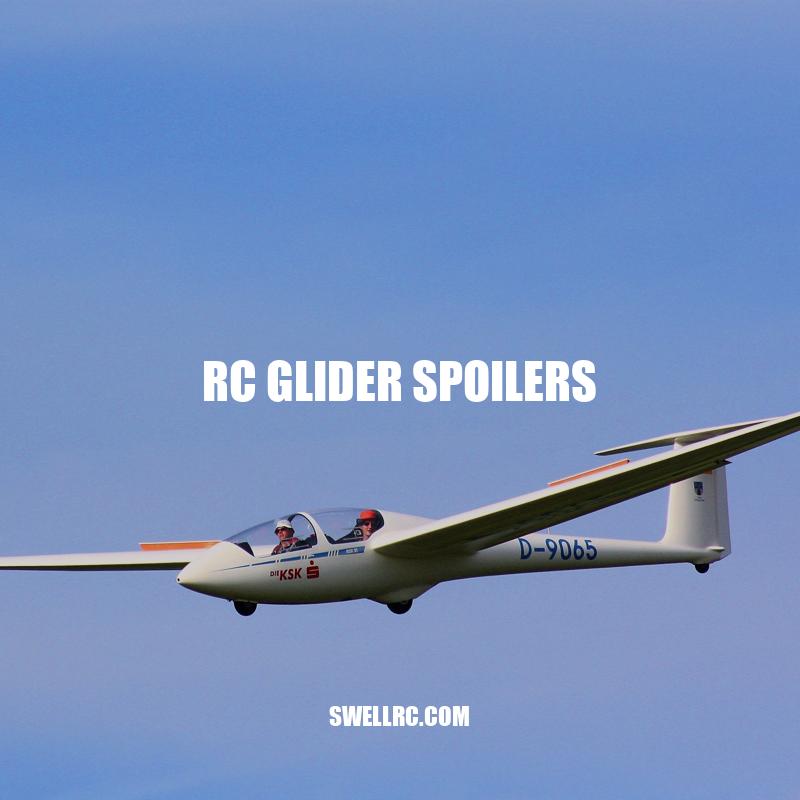Mastering RC Glider Spoilers: Tips and Types
RC gliders have become increasingly popular amongst enthusiasts looking for a unique and challenging hobby. These miniature aircraft are flown without an engine, using only air currents and winds for propulsion and lift. This requires a great deal of skill and knowledge to control and maneuver them through the air. One essential component of any RC glider is the spoiler. Spoilers are airbrakes that reduce lift, increase drag, and provide a controlled descent when needed. They are mounted on to the top surface of the wings and can be extended or retracted by servos depending on the desired effect. The different types of spoilers include butterfly, spoileron, and camber-changing spoilers. Each plays a different role in controlling and maintaining the glider’s stability in flight. In this article, we will explore the importance of RC gliders spoilers, how they work, and their role in the world of model aviation. If you are an RC glider enthusiast, or are interested in learning more about model aviation, then this article is for you.
RC glider spoilers are an essential component of any RC glider’s design and play a vital role in controlling the glider’s flight. They are located on the top surface of the glider’s wings and are typically operated by servos, which extend or retract them as needed. Here are some key functions of RC glider spoilers:
- Reducing lift: When spoilers are extended, they disrupt the smooth airflow over the wings, reducing the amount of lift provided by the wings and causing the glider to descend more quickly.
- Increasing drag: Spoilers also increase drag, providing resistance to the forward motion of the glider. This helps control the glider’s speed and helps to maintain its stability in flight.
- Assisting in landings: Spoilers are valuable during landings as they allow pilots to control the glider’s descent more precisely and ensure safe landings with a controlled, slower speed.
- Enhancing maneuverability: Spoilers can be used to perform more advanced maneuvers such as stall turns, snap rolls, and loop-de-loops, and to improve directional control.
Proper use and installation of spoilers are key in maximizing their function and efficiency in an RC glider. If you are new to RC flying, websites such as RCGroups.com, RC Universe, and RC Planet offer helpful resources for learning more about model aviation and finding products such as pre-built RC gliders, building kits, and spoiler systems.
What do spoilers do on a glider?
Spoilers on a glider are used to reduce the lift generated by the wings. This helps the glider to descend more quickly and can be useful for landing or losing altitude. Spoilers can also be used to control the glider’s speed and descent rate. Some popular glider manufacturers that offer spoilers as an option include Alexander Schleicher, Schempp-Hirth, and DG Flugzeugbau.
| Manufacturer | Glider Models with Spoiler Option |
| — | — |
| Alexander Schleicher | ASG 29, ASW 27, ASW 24 |
| Schempp-Hirth | Ventus 2, Discus 2, Nimbus 4 |
| DG Flugzeugbau | DG-1001, DG-800S |
- Spoilers reduce lift generated by the wings.
- They help the glider descend quickly and control speed/descent rate.
- Alexander Schleicher, Schempp-Hirth, and DG Flugzeugbau offer spoilers as an option on their glider models.
Different Types of RC Glider Spoilers
There are several types of RC glider spoilers available, each with unique advantages and disadvantages. Here are some common types of spoilers used in RC gliders:
| Type | Description | Advantages |
|---|---|---|
| Butterfly spoilers | Two separate panels on each wing that are hinged to open up simultaneously | Provide the most lift reduction out of any spoiler type |
| Camber-changing spoilers | Spoilers that alter the curvature of the wings, reducing the drag when closed and increasing drag when opened | Offers control over both lift and drag while also increasing glide efficiency |
| Spoilerons | Spoilers that also function as a control surface and are integrated into the ailerons of the wing | Has an added advantage of enhancing directional control |
In addition to the above types of spoilers, there are variations and combinations of spoilers that can further enhance an RC glider’s aerodynamics. The amount of spoiler required depends on the size and weight of the glider. RC pilots often experiment with different types of spoilers and spoiler combinations to find the most efficient setup for their individual glider.
If you are looking for pre-built RC gliders, building kits, or spoiler systems, websites such as SoaringUSA.com, Tower Hobbies, and Hobby King offer a wide selection of products in various price points. Some RC glider enthusiasts even build their own custom spoilers for their gliders, employing techniques such as carbon fiber layup or 3D printing for more specialized and unique designs.
What are the different types of spoilers on aircraft?
There are several types of spoilers on aircraft, including:
- Ground spoilers: These are used on landing and work by disrupting the lift to reduce the aircraft’s speed and increase the weight on the wheels for better braking.
- Flight spoilers: These disrupt the lift during flight and are used to slow down the aircraft or control descent rate.
- Spoilerons: These act as both spoilers and ailerons, which allow for roll control and speed reduction.
- Spoiler flaps: These are used on high-lift systems and are designed to increase drag and reduce lift on the wings.
This is just a brief overview, and there may be other types of spoilers on specific aircraft models. For more information, you can refer to aviation websites such as FlightGlobal or Boeing’s official website.
Installation and Usage of RC Glider Spoilers
Installing and setting up RC glider spoilers can vary based on the type of spoiler and the type of glider. Here are some general tips for installing and using RC glider spoilers:
- Mount spoilers on the top of the wings, with servos used to extend and retract them
- Calibrate the servos to ensure proper operation of the spoilers
- Practice using the spoiler during flight, observing the aircraft’s rate of descent and adjusting the spoiler’s position as necessary
- Determine appropriate flight conditions for spoiler use and monitor these conditions throughout the flight
- Use spoilers during landing to ensure controlled and accurate approach
- Master the control of the spoilers during flight and landing with consistent practice
Several resources are available for beginner-level information on RC gliders, including instructional videos, online forums, and user groups. RC glider enthusiasts have developed and shared tips and tricks to use spoilers more efficiently and to avoid damage or misoperation of the spoilers.
If you are looking for additional resources or information about RC gliders or spoilers, a number of websites offer forums and communities for RC pilots. Websites such as RCGroups.com and RCUniverse.com provide a wealth of knowledge on topics related to RC gliders and their spoilers, including product reviews, user forums, and advice from experienced RC pilots.
Why do gliders use spoilers?
Gliders use spoilers to reduce lift and increase drag, which helps to control the glider’s speed and altitude during flight. Spoilers work by disrupting the airflow over the wing, causing a decrease in lift and an increase in drag. This helps glider pilots to descend more quickly, maintain a consistent glide path, or reduce speed during landing. Spoilers can also be used to compensate for the effects of thermal currents, which can cause a glider to gain altitude unexpectedly. Spoilers are a standard feature on most gliders and can be manually or automatically deployed by the pilot.
For more information on gliders and aviation, visit the websites of organizations such as the Soaring Society of America or the British Gliding Association. There are also many products available for glider pilots, such as flight instruments, navigation tools, and safety equipment, which can be found through aviation retailers and online stores.
Conclusion
RC glider spoilers are an important component of the aerodynamics of radio-controlled gliders, providing the ability to reduce lift and increase drag. Their installation and usage may vary by type and proper operation is crucial for effective control during flight. By understanding the different types of spoilers and how they are installed and used, pilots can enhance the accuracy and control of their RC gliders.
While there are many resources available online for RC glider enthusiasts, it is important to consult reliable sources and purchase quality products that meet industry standards. Learning to use the spoilers effectively can be both challenging and rewarding, and we recommend practicing with them to master their control in-flight and during landing.
Whether you are a beginner or an experienced pilot, adding a set of spoilers to your RC glider can provide additional excitement and challenge to your flying experience. Mastery of RC glider spoilers can enhance the accuracy, control, and overall performance of your glider, allowing for more thrilling flight experiences and impressive landings.



